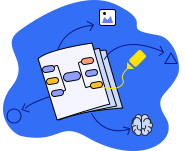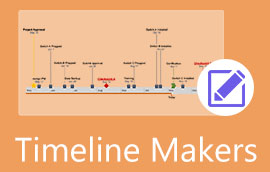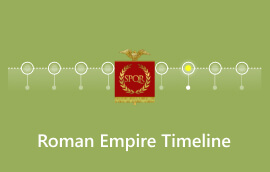An Introduction to the History of the U.S. Timeline
It is hard to study the history of the United States in one sitting. This is where a timeline comes in handy. The timeline divides and illustrates the events chronologically, allowing you to understand them easily. Yet, some readers want to learn about the U.S. history timeline. If you’re one of them, you are in the right post to read. Use this guide to learn the necessary information you need. Likewise, we have added the top-rated tool to create a comprehensive timeline.

- Part 1. U.S. History Timeline
- Part 2. U.S. History Timeline Major Events
- Part 3. FAQs About U.S. History Timeline
Part 1. U.S. History Timeline
Take a look at the visual representation of the U.S. timeline below. The comprehensive timeline of US history was made with the use of MindOnMap. If you also want to know how this was made, keep reading as we made a complete guide for you, too.
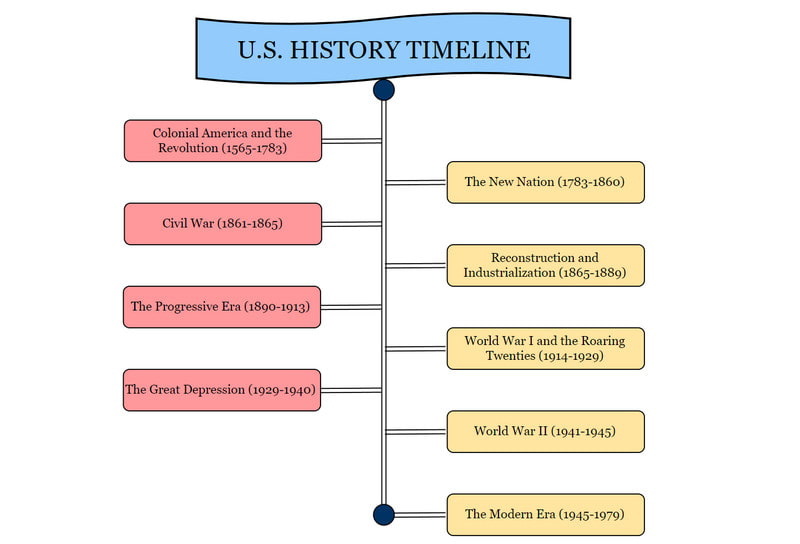
Get a detailed U.S. history timeline.
To learn more about the United States' history, here’s an explained timeline you can explore and read for your reference.
Colonial America and the Revolution (1565-1783)
In 1607, Jamestown, Virginia, was established as the first permanent English settlement. In 1775, the American Revolutionary War began. It also led to the Declaration of Independence on July 14, 1776. Finally, the Treaty of Paris (1873) recognized American independence.
The New Nation (1783-1860)
In 1787, the Constitutional Convention approved the U.S. Constitution after some debate. Benjamin Henry Latrobe became Surveyor of Public Buildings and Grounds for the nation’s capital in 1802. He is an English immigrant invited by President Thomas Jefferson. In 1860, Abraham Lincoln was elected president, leading to tensions between North and South.
Civil War (1861-1865)
1861-1865, the Civil War between the Northern Union and the Southern Confederacy took place. Then, the Emancipation Proclamation declared the freedom of enslaved people in Confederate territory in 1863. The U.S. Customs House is one of the surviving structures among the ruins of Richmond.
Reconstruction and Industrialization (1865-1889)
1865-1877 was the reconstruction period to rebuild the South after the Civil War. During the late 1800s, there was rapid industrialization, expansion of railroads, and growth of corporations.
The Progressive Era (1890-1913)
In the early 1900s, the progressive movement addressed problems such as women’s suffrage, workers’ rights, and political corruption. In 1913, the 16th (income tax) and 17th (direct election of senators) Amendments were approved.
World War I and the Roaring Twenties (1914-1929)
The U.S. became involved in World War I during 1917-1918. Then, in 1920, the 19th Amendment allowed women the right to vote. Afterward, the economic prosperity, cultural changes, and prohibition era occurred in the 1920s.
The Great Depression (1929-1940)
In 1929, the stock market crash triggered the Great Depression. As a result, widespread unemployment and economic hardships occurred during the 1930s. Also, President Franklin D. Roosevelt created New Deal policies.
World War II (1941-1945)
Because of the attack on Pearl Harbor, it led to US entry into World War II in 1941. Then, in 1945, the Atomic bombs dropped on Hiroshima and Nagasaki, leading to Japan's surrender.
The Modern Era (1945-1979)
In 1945, World War II also ended. Then, the Cold War began with the Soviet Union. Starting from the 1950s to the 1960s, the civil rights movement, space race, and counterculture took place. And in the 1970s, there was an energy crisis, the Watergate scandal, and the Vietnam War's end.
Bonus Tip: How to Create a Timeline using MindOnMap
To create a timeline, you need dependable software to make your work easier. Although you can find many timeline creators online, MindOnMap still stands out as the best tool.
MindOnMap is a program that lets you create organizational charts, fishbone diagrams, and treemaps, including timelines. It is available in both browser and app versions. With its online version, you can access it on various browsers like Chrome, Safari, Edge, and more. MindOnMap can also be used for different purposes. You can use it to make a relationship map, do a speech or article outline, plan your work, and others. What’s more interesting, it has an auto-saving feature! Whatever changes you make, the tool will save it automatically. Not only that, if you wish to collaborate with your peers or workmates, it is also possible. It is through the tool’s collaborative feature. Given all these points, you can start creating your timeline using MindOnMap. Here’s how:
Download MindOnMap/Create Online
First, go to the official site of MindOnMap. You'll see two options on the website’s interface: Free Download and Create Online. Choose your preferred version, then create an account to access it fully.
Secure Download
Secure Download
Pick a Layout
Now, you will be directed to the New section after creating an account. Also you will also be able to see different layouts. Now, select the Flow Chart option. In this timeline-making tutorial, we used the History of America timeline.

Customize Your Work
On your current window, start creating the timeline. In the left part of your screen, you will see the Shapes options. Add texts, lines, and shapes you want for your timeline. You can also select a Theme and Style on the right-hand side of your window.
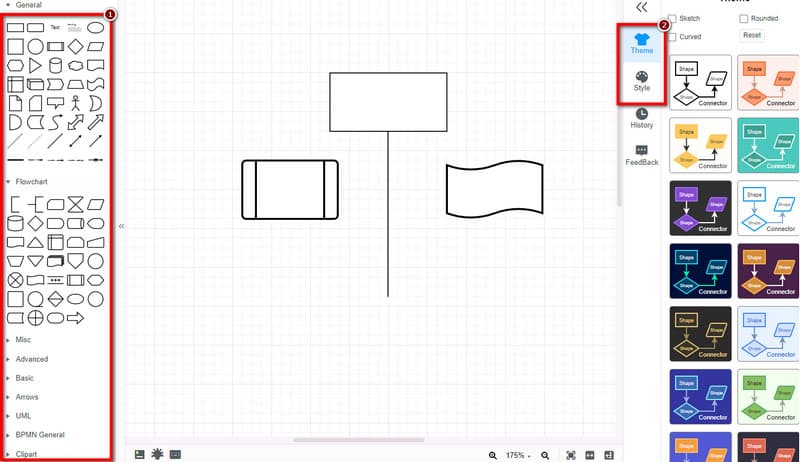
Share Your Work
If you want to work with your friends and colleagues, share it by clicking the Share button at the upper-right-hand corner of the tool. Alternatively, you can set a Password and Valid Period for your timeline before sharing.
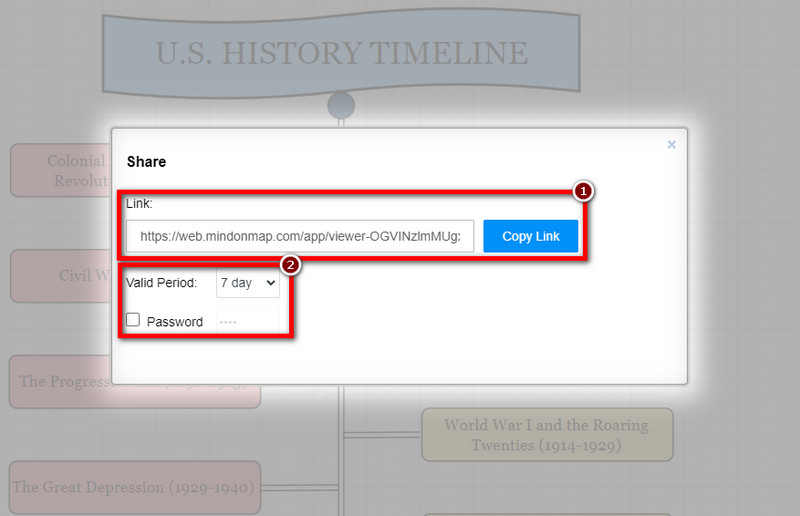
Export Your Timeline
When your timeline is ready, you can now save and download it on your PC. To do it, click the Export button and choose your desired format. Optionally, if you’re not yet done, you can exit the tool and continue working on it later. And all the changes you made will be saved.
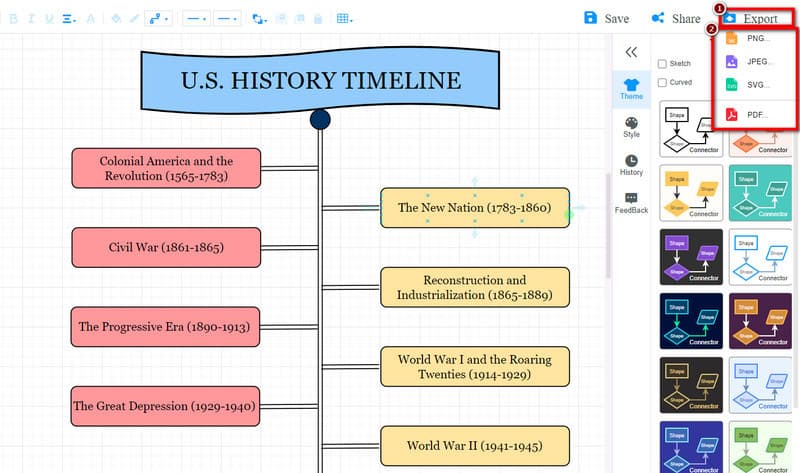
Part 2. U.S. History Timeline Major Events
In this part, we have discussed the major events that shaped the history of the United States.
1. Jamestown (1607)
Jamestown was important in U.S. history since it was its first permanent English settlement in the Colony of Virginia.
2. Boston Tea Party (1773)
The key to the growth of the American Revolution was the Boston Tea Party. Samuel Adams and the Sons of Liberty flung tea into the sea while they boarded three ships.
3. Lexington and Concord (1775)
Lexington and Concord fought, and the American Revolutionary War began. A lot of British troops started to march from Boston to nearby Concord.
4. American Revolutionary War
With many different battles, the American Revolutionary War lasted for 8 years straight. During the war, George Washington was involved as the General Commander or the leader. In 1783, the war ended.
5. The Declaration of Independence (1776)
During the Declaration of Independence, Thomas Jefferson was involved as the main author. The letter was sent to inform the King of England that he was being fired.
6. Louisiana Purchase (1803)
Thomas Jefferson was also present as he was the founder of the Louisiana Purchase. They bought it off for $15 million. After the Louisiana Purchase, James Monroe came.
7. Compromise of 1850
Compromise of 1850 comprises 5 laws passed by the United States in September 1850. It temporarily diffused tensions between enslaved people and free states until the American Civil War.
8. Lincoln’s Assassination (1865)
The death of Abraham Lincoln is also considered one of the major events that happened in United States history. He was shot by a well-known stage actor, John Wilkes Booth, in Washington, D.C.
Further Reading
Part 3. FAQs About U.S. History Timeline
What are the 7 eras in U.S. history?
The 7 eras in U.S. history are Colonization, Revolution, Expansion and Reform, Civil War and Reconstruction, Development of Modern America, World Wars, and Contemporary America.
What are the 5 most important dates in history?
The 5 most important dates in America are July 4, 1776 (Declaration of Independence), January 1, 1861 (Civil War), January 1, 1939 (World War 2), December 7, 1941 (the bombing of Pearl Harbor), and November 22, 1963 (assassination of JFK).
What event came first in U.S. history?
The first event that came in U.S. history was the arrival of the first people in America around 15,000 BC.
Conclusion
As shown above, you learned the U.S. history timeline and its major events. It is also proven that grasping and understanding history with a timeline diagram is much easier. With that, use MindOnMap to make your desired and personalized timeline. Its straightforward interface and functions can help you create a timeline easily and efficiently. To learn more about it, try and experience it today.







